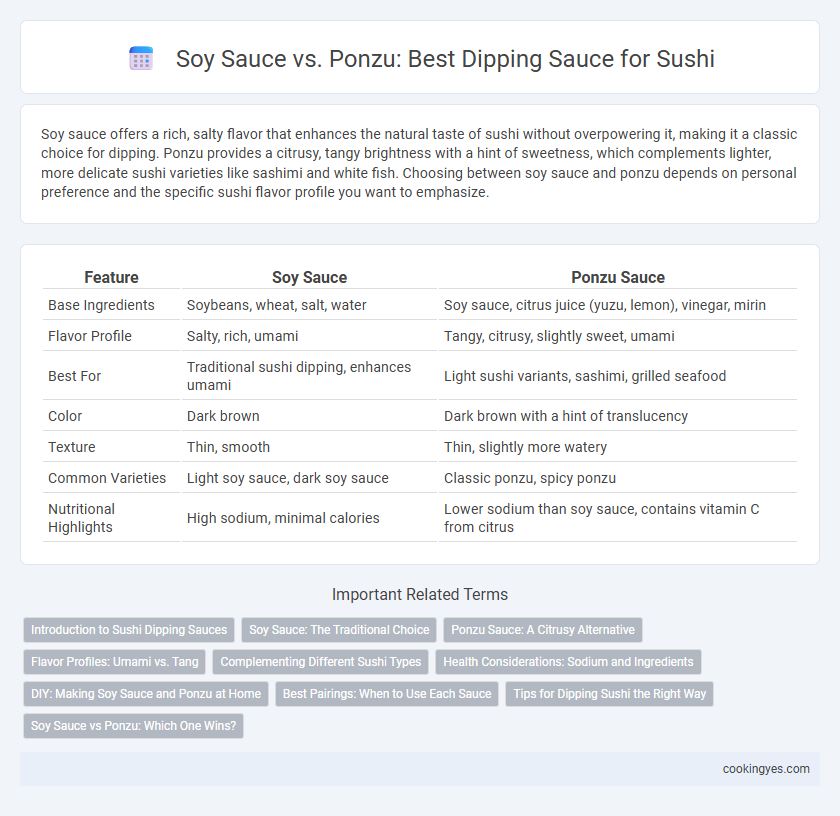Soy sauce offers a rich, salty flavor that enhances the natural taste of sushi without overpowering it, making it a classic choice for dipping. Ponzu provides a citrusy, tangy brightness with a hint of sweetness, which complements lighter, more delicate sushi varieties like sashimi and white fish. Choosing between soy sauce and ponzu depends on personal preference and the specific sushi flavor profile you want to emphasize.
Table of Comparison
| Feature | Soy Sauce | Ponzu Sauce |
|---|---|---|
| Base Ingredients | Soybeans, wheat, salt, water | Soy sauce, citrus juice (yuzu, lemon), vinegar, mirin |
| Flavor Profile | Salty, rich, umami | Tangy, citrusy, slightly sweet, umami |
| Best For | Traditional sushi dipping, enhances umami | Light sushi variants, sashimi, grilled seafood |
| Color | Dark brown | Dark brown with a hint of translucency |
| Texture | Thin, smooth | Thin, slightly more watery |
| Common Varieties | Light soy sauce, dark soy sauce | Classic ponzu, spicy ponzu |
| Nutritional Highlights | High sodium, minimal calories | Lower sodium than soy sauce, contains vitamin C from citrus |
Introduction to Sushi Dipping Sauces
Soy sauce, a traditional Japanese condiment made from fermented soybeans, offers a rich umami flavor that complements the subtle taste of sushi rice and fresh fish. Ponzu, a citrus-based sauce blending soy sauce with yuzu or lemon juice, provides a tangy, refreshing alternative that enhances lighter sushi varieties like sashimi or white fish. Both sauces serve as essential accompaniments, balancing savory and acidic notes to elevate the overall sushi dining experience.
Soy Sauce: The Traditional Choice
Soy sauce remains the traditional choice for sushi dipping due to its rich umami flavor and balanced saltiness that enhances the natural taste of fresh fish. Made from fermented soybeans, wheat, salt, and water, authentic soy sauce provides a smooth, savory profile that complements a wide variety of sushi types. Its widespread availability and long-standing cultural significance make soy sauce an essential condiment in authentic Japanese dining experiences.
Ponzu Sauce: A Citrusy Alternative
Ponzu sauce offers a vibrant, citrus-infused alternative to traditional soy sauce, enhancing sushi with its tangy, refreshing flavor profile derived from yuzu, lemon, and lime juice combined with soy sauce and dashi. This light, umami-rich condiment complements fatty sushi varieties like salmon and toro, balancing richness without overpowering delicate fish textures. With lower sodium content than regular soy sauce, ponzu appeals to health-conscious diners seeking a zesty, flavorful dip for sushi.
Flavor Profiles: Umami vs. Tang
Soy sauce offers a deep umami flavor with salty, savory notes that enhance the natural taste of sushi ingredients. Ponzu sauce provides a bright, tangy citrus zest balanced with mild umami, creating a refreshing contrast to richer sushi flavors. Choosing between soy sauce and ponzu depends on whether you prefer a traditional umami boost or a lighter, tangy accent for dipping.
Complementing Different Sushi Types
Soy sauce enhances the umami flavors of traditional sushi types like nigiri and sashimi, complementing fish with its rich, salty profile. Ponzu's citrusy and tangy notes brighten lighter sushi varieties such as white fish and scallops, offering a refreshing contrast that balances their delicate taste. Choosing between soy sauce and ponzu depends on the sushi's flavor intensity, with soy sauce deepening robust flavors and ponzu elevating subtler ones.
Health Considerations: Sodium and Ingredients
Soy sauce and ponzu differ significantly in sodium content and ingredient composition, affecting their health impact. Traditional soy sauce contains high sodium levels, often exceeding 900 mg per tablespoon, which can contribute to increased blood pressure and cardiovascular risk. Ponzu, made from citrus juice combined with soy sauce or vinegar, tends to have lower sodium and adds vitamin C and antioxidants, making it a healthier option for dipping sushi.
DIY: Making Soy Sauce and Ponzu at Home
Making soy sauce at home involves fermenting soybeans with wheat, salt, and specific molds over several months, resulting in a rich, umami-packed dipping sauce perfect for sushi. Ponzu sauce combines soy sauce with citrus juice, vinegar, mirin, and dashi, offering a tangy, refreshing flavor profile that complements lighter sushi varieties. DIY preparation allows customization of saltiness, sweetness, and acidity, enhancing the sushi experience with personalized dipping sauces.
Best Pairings: When to Use Each Sauce
Soy sauce's rich, salty umami pairs perfectly with traditional sushi like nigiri and sashimi, enhancing the natural flavors without overpowering them. Ponzu, with its citrusy and tangy notes, complements fattier fish like salmon or tempura rolls, adding a refreshing zest that balances richness. For sushi with subtle flavors, soy sauce provides a classic dip, while ponzu works best with dishes requiring a bright, acidic contrast.
Tips for Dipping Sushi the Right Way
For the perfect sushi experience, use soy sauce sparingly to avoid overpowering delicate fish flavors while dipping only the fish side, not the rice, to maintain texture. Ponzu offers a citrusy, lighter alternative with umami notes, ideal for richer fish types like fatty tuna or eel, enhancing flavor without heavy saltiness. Experiment with dipping depth and frequency to complement sushi's natural taste and balance, ensuring each bite stays fresh and flavorful.
Soy Sauce vs Ponzu: Which One Wins?
Soy sauce offers a rich, salty umami flavor that enhances the natural taste of sushi, making it a classic choice for dipping. Ponzu, a citrus-based sauce with tangy and slightly sweet notes, provides a refreshing contrast that can brighten the flavors of fish and seafood. Choosing between soy sauce and ponzu depends on personal preference, but soy sauce remains the traditional and more versatile option in sushi dining.
Soy Sauce vs Ponzu for dipping sauces Infographic

 cookingyes.com
cookingyes.com